Vessel insurance refers to two types of coverage: hull and indemnity. In other words, one covers the value of the yacht and the other the liability of the owner. The difference between “boat insurance” and “yacht insurance” is that in yacht insurance you get what is known as “agreed value”. In case of loss, no depreciation is taken.

Virtually all new vessels carry insurance while many older boats do not. As some skippers put it, “it’s a better investment to put the premium money in an extra anchor”. Insurance options are almost unlimited. Certain boats are uninsurable as are certain blue water passages or certain destinations. In the end, where the purchaser obtains free title to a yacht, it will be his call to determine what type of insurance, if any, is appropriate.
Most insurance companies in Thailand will require a survey if you are purchasing an older yacht. A survey is also a good way to locate potential problems. Not all surveyors are alike, however. Check the references of the marine surveyor – Gulf Charters has several they work with who they can recommend. In the event of mistakes by a surveyor, which leads to the purchase of a defective vessel, the only real comfort will be an error and omissions policy covering the surveyor, there is really little recourse, so be sure to investigate in detail what the surveyor finds as well as your own detailed inspection of the vessel.
If the plan is to charter out the yacht, appropriate arrangements should be made and a business plan should be prepared. Most charter companies, for example, do not take certain types of boats into their fleets. This information should be on hand before a yacht is purchased. The financial and tax consequences of placing a yacht into charter service can also be significant. You should get all of the details from the yacht charter company before you finalize your purchase.
As in the case of a charter, sharing the yacht is a decision which will seriously affect the use of the yacht. Along with the sharing of expenses, a sharing arrangement also calls for the assignment of rights and duties of the co-owners. Finding a partner for the ownership of a yacht is akin to finding a roommate. There is no substitute for the search of a compatible person with a compatible schedule and needs. But certain rules should be in writing in the form a co-ownership agreement. The agreement should spell out how and where the yacht is to be kept and used, how it will be financed and insured, who will provide the maintenance, who and when will use it, a conflict resolution clause and other items.
The purchase of a used yacht also presents a complication which is not encountered in real estate and automobile acquisitions. In addition to the regular liens of record such as mortgages, vessels are subject to maritime liens, also known as hidden liens. A person who has performed work on the yacht or provided services or supplies to it may have a claim against the vessel itself and therefore a lien. The owner of a lien on the vessel can bring a proceeding against the vessel itself. Some liens may be registered with the local authority where the vessel has been registered or used, but that is not always the case. Yachts can move and incur liability in areas that are very far from the point of sale. There is no certain way to identify all possible liens and the history of the vessel is usually the best way to establish clear title.
NB: In part 3 of the guide next week we cover initial purchasing costs, vessel depreciation, quantity v quality and how to spot the difference.




